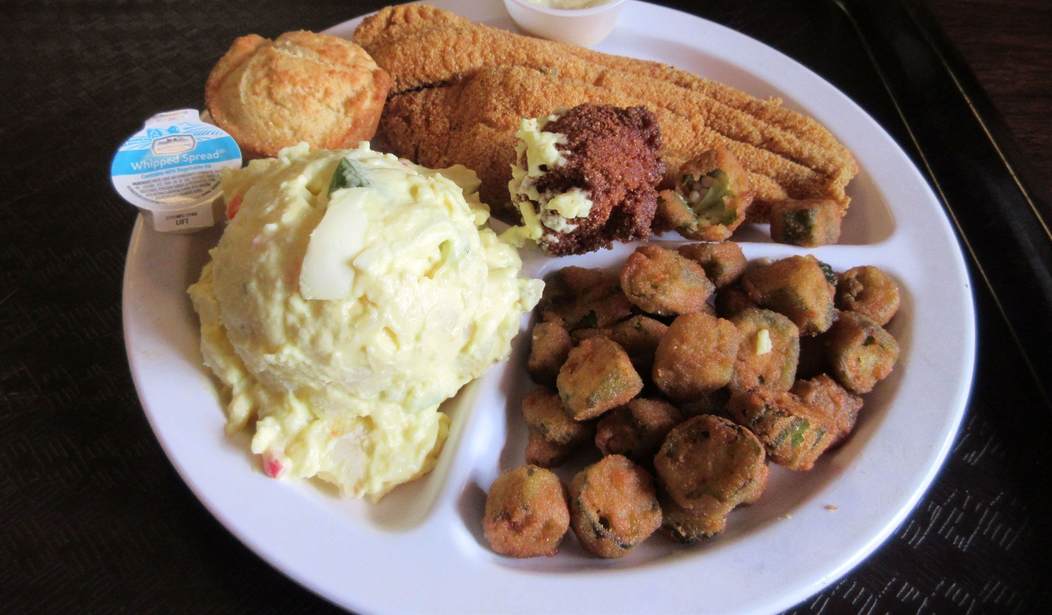"It looks like little teeth, and it just weird and freaks me out." That's what a Yankee friend of mine said to me when we were sitting in a restaurant in Hilton Head, S.C., a few summers ago, and I'd just ordered a plate of food that was heavy on a vegetable that I'd grown up eating without a second thought.
Up until that point, I didn't realize it was so "weird," especially to those north of the Mason-Dixon line. I mean, I knew it was a Southern staple, but I didn't know that some people were literally disgusted by it. I'd never even noticed that it supposedly looked like "teeth."
And a Google search tells me that a lot of people are turned off by the texture. Admittedly, it can be a little slimy, but that doesn't bother me either. I just thought it was something tasty that everyone ate from time to time, a side dish on most restaurant menus, but my friend said the only time she'd ever encountered it back home was at the Cracker Barrel.
I'm talking about okra, of course.
Life & Thyme has a nice article about it, but I had to laugh at this intro:
The first time James Beard award-winning food historian and Koshersoul author Michael W. Twitty ate okra, he hated it. 'I pretended to eat it and swallow it. And then I walked upstairs and spat it out into the bathroom sink,' he says. In the United States outside of the South, okra is often polarizing. While the vegetable’s grassy taste brings comfort for many, okra’s fibrous exterior and unique texture has been known to trigger repulsion. However, across the Southern part of the country, the food is revered. Here, opinions surrounding okra are less about 'if you like it,' and more about 'how you like it.'
When my colleague here, Victoria Taft, saw that I was writing about it behind the scenes, she told me, "I ate fried okra at a restaurant in Alabama recently and it was good. Otherwise, that stuff is dreck. Not that you asked, but also as a gardener, I would never grow that stuff." (In case you don't know, she's not a Southerner. She's out on the West Coast.)
The funny thing is that just days before she told me this, I'd gone out to my own long-neglected summer garden and cleared out a few rows and threw some last-minute okra seeds into the ground. I've been wanting to grow some for years, but never quite seem to get around to it. I grew up watching my grandfather and father grow it in expansive rows across our family property so that my grandmother and mother could fry it up for what seemed like every meal we ate between July and October in those days. My dad swears police helicopters used to fly low over our land to make sure he wasn't growing marijuana.
It's super easy to grow. It doesn't require a lot of soil amendments and does well in sandy soil. It thrives in hot tropical and subtropical weather and can even tolerate a little bit of drought, though it does best with consistent moisture (but avoid keeping it waterlogged).
If you've ever seen okra growing in a field, you know it's beautiful. The plants can grow up to eight feet tall, and pale yellow flowers with reddish-purple centers form up and down their stately stalks. If you keep picking it, they'll do so until it gets cold. They actually look a lot like my favorite flower, the hibiscus, but they also happen to be in the same family, along with cotton and cocoa. This is what I hope to see in a couple of months. As I said, okra thrives in hot weather, and here in Georgia, we've still got a few months of that ahead.
The unexpected beauty of an okra blossom pic.twitter.com/B37buoMKnH
— Melissa the Hopeful🏠Homemaker (@BiblicalBeauty) July 20, 2025
Just remember to pick the pods early. If you wait more than a few days, they'll become woody and inedible. That said, you can still use them to make stocks, dry them, and turn them into powder to season other foods, or even find use for them outside the kitchen. Some people use it for hair care. My mom used to save those old dry pods and make Christmas ornaments out of them.
Okra is a powerhouse crop! 🌱 Easy to grow, pest-resistant, and packed with nutrients. Harvest young, tender pods every 2–3 days for best taste! 🫛 pic.twitter.com/E2cKNRO15w
— Sibobugingo JoëL🇷🇼 (@JoelOptimist1) July 26, 2025
All of that said, while I love to eat and grow okra, I've always been fascinated by the cultural and historical nuances of it. Something I don't think many people realize is how the crop came to be such an iconic Southern food.
It's believed to have originated in East Africa, specifically in or around Ethiopia. The earliest account of it is from the Spanish botanist Abu al-Abbas al-Nabati, who visited Egypt in 1216 and wrote about the locals eating the pods with flour. The earliest known account of it in the Americas is from Brazil in 1658. Documentation of its arrival in the present-day United States isn't available, but we know that by the mid-18th century, even Thomas Jefferson was growing it in his gardens in Virginia, and by the early 1800s, farmers were working on various cultivars of the crop.
No one knows exactly how it ended up on American soil. Obviously, it came during the slave trade, but there are many arguments about the specifics of its introduction to this part of the world. The general consensus is that enslaved Africans brought the seeds with them, knowing they'd always have food and a taste of their homeland. Some tell stories handed down throughout the generations of African mothers who braided it into their daughters' hair so that they'd have a little piece of home when they arrived at their strange new destinations.
Once they arrived, they planted the okra in their small personal gardens and used it to make soups and stews or fried it and served it with fresh tomatoes — a practice that almost everyone I know here in the South still does today. The seeds were also used to make coffee, roasted and brewed when traditional beans weren't available. It's been said that slaves used okra to make coffee for Confederate soldiers during the Civil War when rations were low.
Today, every little corner of the South has its own way of doing okra. In Louisiana, it's used to make gumbo. Head over to the coasts of South Carolina and Georgia and spend some time in the lowcountry or on the sea islands. You'll find that it's a staple in Gullah Geechee cooking, used to make soups and stews — that slimy substance actually helps thicken them up — or served over rice. Some people throughout the South like to pickle it (though I've never eaten it that way myself). As I said, I grew up eating fried okra, and some people even make okra fritters, which you make using just okra or mix it with green tomatoes. It also pairs well with seafood. And one of my favorite snacks is dehydrated okra chips. Yum!
I'm just scratching the surface here. I actually had this fun idea to write a book about okra a few years ago. I was going to go over its origins, interview various chefs and notable people, and include some favorite recipes and memories. For example, during a podcast with Southern Living a few years ago, country music singer Darius Rucker, who grew up in Charleston, said, "My favorite meal was always Okra soup. It was just okra made with tomatoes and a bunch of vegetables and some ham hocks and all that Southern stuff." I'd love to hear more about that.
But some British chap beat me to it. Perhaps there is room for two such books on the market, especially if one is written by a gal who eats, sleeps, and breathes all things Southern and embraces the culture where she was born and raised? Maybe one day.
Oh well, I could go on, but I basically just wanted to point out that there is more to this weird little green food than many people might realize, especially those of you who live up north or out west. It's a crop that's not just rooted in the ground, but also in the culture of an entire region of the country and a history that dates back centuries, a culture and history worth honoring.










